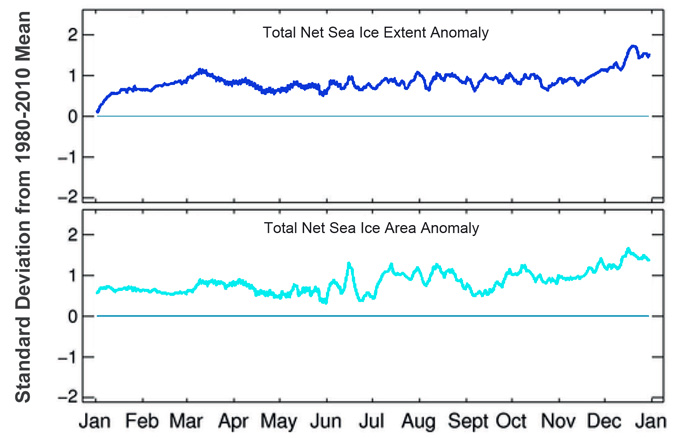| Tweet | Follow @co2science |
Paper Reviewed
Reid, P., Stammerjohn, S., Massom, R., Scambos, T. and Lieser, J. 2015. The record 2013 Southern Hemisphere sea-ice extent maximum. Annals of Glaciology 56: 99-106
Although sea-ice extent in the Northern Hemisphere has been declining for quite some time, Reid et al. (2015) report that the sea-ice extent of the Southern Hemisphere has actually risen, and by approximately "1% per decade since 1979, the year when a continuous record of multi-frequency passive microwave satellite observations began," as has been described by Watkins and Simmonds (2000), Comiso and Nishio (2008), Turner et al. (2009), Comiso (2010) and Parkinson and Cavalieri (2012).
The five researchers also report that on the record-breaking day in 2013, "sea-ice extent was greater than the 30-year average (1981-2010) in nearly all Southern Ocean regions." In fact, they say that "sea-ice extent was well above the long-term average or at a record for the entire year" (see figure below).

Figure 1. Plots of daily anomalies (in standard deviations from the 1991-2010 mean) of total Souther Hemisphere sea ice extent (top panel, blue line) and area (bottom panel, turquoise line) in 2013. Adapted from Reid et al. (2015).
So what's the story here? In a supposedly global-warming world, how could this possibly be?
In the case of the Ross Sea sector of the Southern Ocean, Reid et al. write that the increase in sea-ice extent was likely "a combination of cold southerly winds associated with the position and depth of the Amundsen Sea low," as well as "lower than normal sea surface temperatures (up to 2°C below normal)," such that "the resulting very high anomaly in ice extent in this region was a major component of the overall record maximum."
And thus there exists the documented history of Earth's Southern Ocean, strongly repudiating the climate-alarmist claim of recent and still-ongoing CO2-induced global warming.
References
Comiso, J.C. 2010. Variability and trends of the global sea ice cover. In: Thomas, D.N. and Dieckmann, G.S. (Eds.). Sea Ice. Wiley-Blackwell, Oxford, United Kingdom, pp. 205-246.
Comiso, J.C. and Nishio, F. 2008. Trends in the sea ice cover using enhanced and compatible AMSR-E, SSM/I, and SMMR data. Journal of Geophysical Research 113: 10.1029/2007JC004257.
Parkinson, C.I. and Cavalieri, D.J. 2012. Antarctic sea ice variability and trends, 1979-2010. Cryosphere 6: 871-880.
Turner, J., Comiso, J.C., Marshall, G.J., Lachlan-Cope, T.A., Bracegirdle, T., Marksym, T., Meredith, M.P., Wang, Z. and Orr, A. 2009. Non-annular atmospheric circulation change induced by stratospheric ozone depletion and its role in the recent increase of Antarctic sea ice extent. Geophysical Research Letters 36: 10.1029/2009GL037524.
Watkins, A.B. and Simmonds, I. 2000. Current trends in Antarctic sea ice: the 1990s impact on a short climatology. Journal of Climate 13: 4441-4451.
Posted 9 March 2016



